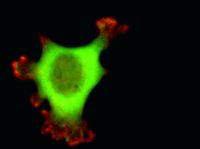Compact Diode Lasers for High-Content Screening
High-content Analysis (HCA) and High-content Screening (HCS)
High-content analysis (HCA) and high-content screening (HCS) are essential techniques in modern cell biology as well as in drug discovery and pharmaceutical research. Using automated high-resolution microscopy coupled with analytical software to visualize and quantify phenotypic responses in cells, HCS determines how compounds such as small molecule drugs, antibodies, or RNAi experiments, affect cell morphology in a fast, quantitative, high-throughput manner, providing meaningful functional readouts of cellular activity.
Sample preparation
Most HCS experiments are cell based assays but sometimes also tissue slices or whole embryos are studied. The cells are usually grown on multi-well plates – each well representing a different experiment. The cells in each well are treated differently, for example different drugs are added to each well in order to study their effect on cell viability or other parameters. In order to visualize the effect of the treatment on the sample, structures of interest within the cells (e.g. nucleus, cytoplasm, cell membrane, etc.) are either stained with different fluorescent dyes or cell-lines expressing proteins that are tagged with fluorescent proteins are used.
Imaging system
HCS systems are basically fully automated microscopes: an automated stage moves the multi-well plate from position to position (according to a previously defined protocol) and at each position the same imaging procedure is performed. Dichroic mirrors and filters are automatically switched, the sample is illuminated at one or more excitation wavelengths and the images are recorded with a CCD camera. Optionally also brightfield images are recorded. A combination of a laser-based autofocus system and a software-based autofocus procedure ensure that the sample is always in focus during imaging. HCS systems are available in widefield configuration or as confocal setup as for certain experiments optical sections or 3D imaging is required. The confocal HCS systems usually employ a spinning disk technique to ensure fast image acquisition. For fluorescence excitation the systems are equipped either with Mercury or Xenon light sources or with lasers, which are frequently used in confocal HCS systems. When pulsed lasers are employed this opens also the possibility for FLIM HCS experiments. Optionally, HCS systems are often equipped with a loading robot to transport the multi-well plates from sample preparation to the HCS system, barcode readers to identify each plate and liquid handling systems to add or remove liquid from the plates. Furthermore, the HCS systems can be equipped with an incubation chamber which controls temperature, humidity and CO2 in order to keep cells alive for time-lapse experiments.
Image analysis
After image acquisition the images are automatically analyzed, according to a previously defined protocol. During image analysis a segmentation algorithm detects individual cells in every image. For each detected cell various parameters depending on the experiment that is performed are analyzed. For example intensities and spatial distribution of the fluorescent markers within the cell (or its organelles), the area of various cellular structures and other geometric parameters are quantified.
TOPTICA’s diode laser iBeam smart is a one-box laser that is available at distinct wavelengths from 375 nm to 1060 nm, covering excitation wavelengths of dyes and fluorescent proteins from UV to IR for multi-color imaging. The iBeam smart shows perfect power stability and lowest noise and ensures therefore reliable and reproducible results over time. The iBeam smart can be operated in cw and in pulsed mode; fast direct modulation capabilities allow fast switching of different excitation wavelengths. Highest output powers guarantee high acquisition speed and thus provide high throughput also in confocal HCS systems. Furthermore, the small footprint allows easy integration into HCS systems. High reliability, low maintenance as well as long life time ensure 24/7 operation compulsory for high content screening systems.

